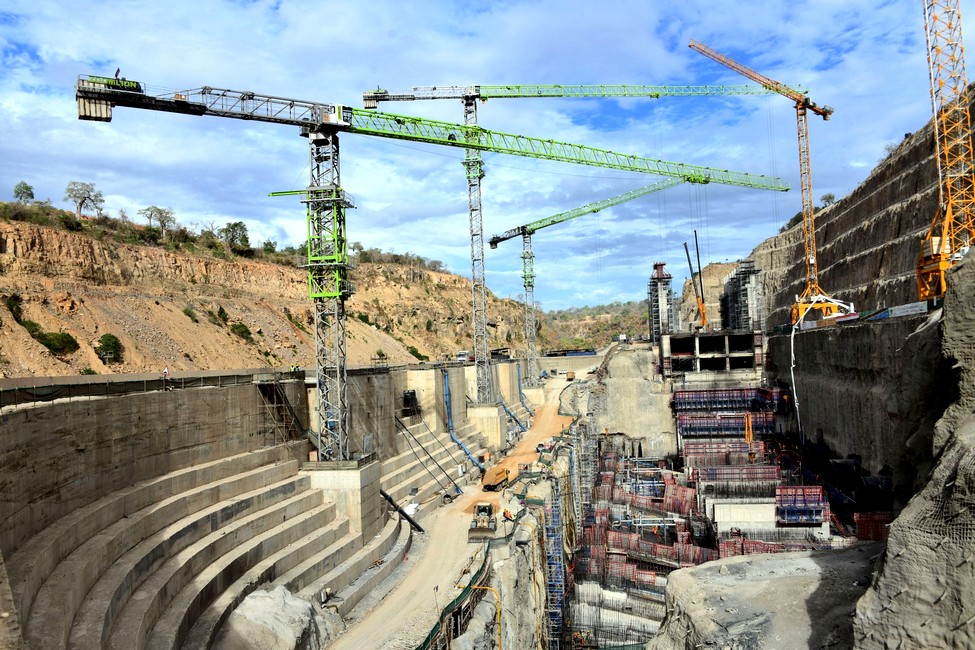As the Julius Nyerere Hydropower Project (JNHPP) reached 91.72 per cent of implementation, while it is expected to start production in 2024 and increase the level of electricity production in the country, it aims to stimulate the economic growth of the people and the preservation of the environment.
The project, valued at Sh6.6 trillion, is expected to generate 2,115 megawatts of electricity. This will help alleviate the power outages in the country attributed to water shortages in the dams used for electricity generation.
Nyerere Hydropower Project
Rufiji Valley is the largest valley in Tanzania. Rufiji Valley covers 177,000 square kilometres, starting in the southwest part of the country and traversing to the Indian Ocean.
The upper Rufiji River is fed by various rivers, including the Kilombero River, which contributes 65 per cent of water; Ruaha River, which pours in 15 per cent of water; Luwegu River, which contributes 19 per cent, and the remaining one per cent comes from small rivers.
Nyerere Hydropower project is located along Latitude S70 48′ and Longitude E 370 51′ within Selous Game Reserve, the largest reserve in the country, covering 50,000 square kilometres.
Management of the Project Policy
Development of the JNHPP is being managed by the Energy Policy 2015, which aims to enable the country to reach 75 per cent of power distribution by 2025. The primary national objective aligns with the global target of ensuring power availability to all people.
The policy states that special precautions should be taken to expand power generation from alternative energy sources abundantly available in the country.
According to Tanzanian Electricity Company (TANESCO), the Julius Nyerere Hydropower Project (JNHPP), which harnesses the waters of the Rufiji River to generate electricity, has been completed. The project is expected to yield numerous benefits, including an increased supply of electricity for the country and the mitigation of flooding risks.
In addition to alleviating flooding, the project is set to facilitate large-scale irrigation covering 200,000 hectares. This initiative will benefit farmers by providing enhanced irrigation capabilities through the project.
Furthermore, the project is poised to bring about additional benefits, including fishing and livestock farming opportunities. Many animals will have access to water, reducing the need for extensive travel. The project is expected to contribute to a decrease in electricity prices and ensure a reliable power supply. Also, the area around the reservoir is anticipated to attract tourism, as numerous animals will be drawn to the water, creating opportunities for wildlife viewing.
The project’s reliability in electricity provision is likely to attract investors, and the expansive reservoir, spanning 55,000 square kilometres, offers potential for developing tourist accommodations, such as hotels on the islands within the pool.
Environmental Conservation
It was revealed during the event first to fill the Nyerere Hydropower dam. President Samia stressed the need to conserve the environment to ensure the long-term viability of the source of power generation.
The Head of State made it clear that the government has invested a lot of money in the project, saying if everyone protects the environment, especially those in the source and tributaries of the rivers that feed the dam, its benefits would be realized on all fronts. President Samia told Tanzanians that conserving the environment to protect the project should now be treated as a matter of life and death.
The Minister of Energy, who is currently the Minister of Foreign Affairs and East African Co-operation, January Makamba, announced that his ministry, through the Tanzania Electric Supply Company (Tanesco), has allocated TZS 5 billion for environmental conservation efforts in water sources and rivers flowing into the Nyerere Hydroelectric Power Project (JNHPP) reservoir.
He adds that the funds will educate residents in various areas, encouraging them to conserve the environment and avoid water pollution. This initiative aims to ensure the sustainability of the reservoir for over 80 years.
The Minister of State in the Office of the Vice President responsible for Union Affairs and Environment, Dr Seleman Jafo, commended the National Environmental Management Council (NEMC) for its effective oversight of environmental regulations in the hydroelectric power project at Mwalimu Nyerere Dam (JNHPP).
The National Environment Management Council (NEMC) quotation states, “This project is a large-scale endeavour with numerous activities generating various types of waste, and with a population of approximately 12,000 people, maintaining a clean environment is not a given. All these efforts are attributed to the Environmental Council, which has set up camp here to ensure that the Environmental Management Law is enforced, particularly in conducting Environmental Impact Assessments.”
In addition to that, Jafo emphasized the conservation of water sources in the Kilombero and Ruaha rivers, citing the benefits of the Mwalimu Nyerere Dam hydroelectric power project as reliable electricity supply, flood control, promotion of irrigation farming, reduction of reliance on wood and charcoal for energy, and enhancement of skills for our country’s professionals.
The government’s commitment to environmental conservation through dedicated funding and collaboration with relevant agencies like NEMC is a positive step. Moving forward, striking a balance between economic development and ecological protection will be crucial in ensuring the project’s long-term viability and maximizing its benefits for present and future generations of Tanzanians.
Further research, monitoring, and ongoing community engagement and education efforts will mitigate environmental risks and ensure the project’s success. Ultimately, the JNHPP’s legacy will depend on its ability to deliver on its promises of economic prosperity while contributing to a sustainable future for Tanzania’s natural resources and biodiversity.
Find and read more developmental analyses here.

